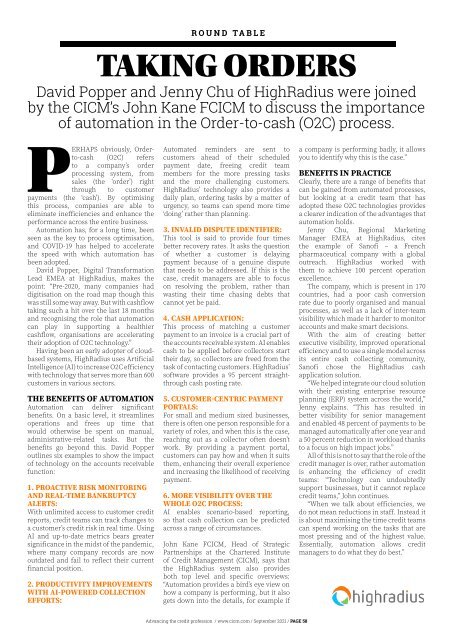CM September 2021
Create successful ePaper yourself
Turn your PDF publications into a flip-book with our unique Google optimized e-Paper software.
ROUND TABLE<br />
TAKING ORDERS<br />
David Popper and Jenny Chu of HighRadius were joined<br />
by the CI<strong>CM</strong>’s John Kane FCI<strong>CM</strong> to discuss the importance<br />
of automation in the Order-to-cash (O2C) process.<br />
PERHAPS obviously, Orderto-cash<br />
(O2C) refers<br />
to a company’s order<br />
processing system, from<br />
sales (the ‘order’) right<br />
through to customer<br />
payments (the ‘cash’). By optimising<br />
this process, companies are able to<br />
eliminate inefficiencies and enhance the<br />
performance across the entire business.<br />
Automation has, for a long time, been<br />
seen as the key to process optimisation,<br />
and COVID-19 has helped to accelerate<br />
the speed with which automation has<br />
been adopted.<br />
David Popper, Digital Transformation<br />
Lead EMEA at HighRadius, makes the<br />
point: “Pre-2020, many companies had<br />
digitisation on the road map though this<br />
was still some way away. But with cashflow<br />
taking such a hit over the last 18 months<br />
and recognising the role that automation<br />
can play in supporting a healthier<br />
cashflow, organisations are accelerating<br />
their adoption of O2C technology.”<br />
Having been an early adopter of cloudbased<br />
systems, HighRadius uses Artificial<br />
Intelligence (AI) to increase O2C efficiency<br />
with technology that serves more than 600<br />
customers in various sectors.<br />
THE BENEFITS OF AUTOMATION<br />
Automation can deliver significant<br />
benefits. On a basic level, it streamlines<br />
operations and frees up time that<br />
would otherwise be spent on manual,<br />
administrative-related tasks. But the<br />
benefits go beyond this. David Popper<br />
outlines six examples to show the impact<br />
of technology on the accounts receivable<br />
function:<br />
1. PROACTIVE RISK MONITORING<br />
AND REAL-TIME BANKRUPTCY<br />
ALERTS:<br />
With unlimited access to customer credit<br />
reports, credit teams can track changes to<br />
a customer’s credit risk in real time. Using<br />
AI and up-to-date metrics bears greater<br />
significance in the midst of the pandemic,<br />
where many company records are now<br />
outdated and fail to reflect their current<br />
financial position.<br />
2. PRODUCTIVITY IMPROVEMENTS<br />
WITH AI-POWERED COLLECTION<br />
EFFORTS:<br />
Automated reminders are sent to<br />
customers ahead of their scheduled<br />
payment date, freeing credit team<br />
members for the more pressing tasks<br />
and the more challenging customers.<br />
HighRadius’ technology also provides a<br />
daily plan, ordering tasks by a matter of<br />
urgency, so teams can spend more time<br />
‘doing’ rather than planning.<br />
3. INVALID DISPUTE IDENTIFIER:<br />
This tool is said to provide four times<br />
better recovery rates. It asks the question<br />
of whether a customer is delaying<br />
payment because of a genuine dispute<br />
that needs to be addressed. If this is the<br />
case, credit managers are able to focus<br />
on resolving the problem, rather than<br />
wasting their time chasing debts that<br />
cannot yet be paid.<br />
4. CASH APPLICATION:<br />
This process of matching a customer<br />
payment to an invoice is a crucial part of<br />
the accounts receivable system. AI enables<br />
cash to be applied before collectors start<br />
their day, so collectors are freed from the<br />
task of contacting customers. HighRadius’<br />
software provides a 95 percent straightthrough<br />
cash posting rate.<br />
5. CUSTOMER-CENTRIC PAYMENT<br />
PORTALS:<br />
For small and medium sized businesses,<br />
there is often one person responsible for a<br />
variety of roles, and when this is the case,<br />
reaching out as a collector often doesn’t<br />
work. By providing a payment portal,<br />
customers can pay how and when it suits<br />
them, enhancing their overall experience<br />
and increasing the likelihood of receiving<br />
payment.<br />
6. MORE VISIBILITY OVER THE<br />
WHOLE O2C PROCESS:<br />
AI enables scenario-based reporting,<br />
so that cash collection can be predicted<br />
across a range of circumstances.<br />
John Kane FCI<strong>CM</strong>, Head of Strategic<br />
Partnerships at the Chartered Institute<br />
of Credit Management (CI<strong>CM</strong>), says that<br />
the HighRadius system also provides<br />
both top level and specific overviews:<br />
“Automation provides a bird’s eye view on<br />
how a company is performing, but it also<br />
gets down into the details, for example if<br />
a company is performing badly, it allows<br />
you to identify why this is the case.”<br />
BENEFITS IN PRACTICE<br />
Clearly, there are a range of benefits that<br />
can be gained from automated processes,<br />
but looking at a credit team that has<br />
adopted these O2C technologies provides<br />
a clearer indication of the advantages that<br />
automation holds.<br />
Jenny Chu, Regional Marketing<br />
Manager EMEA at HighRadius, cites<br />
the example of Sanofi – a French<br />
pharmaceutical company with a global<br />
outreach. HighRadius worked with<br />
them to achieve 100 percent operation<br />
excellence.<br />
The company, which is present in 170<br />
countries, had a poor cash conversion<br />
rate due to poorly organised and manual<br />
processes, as well as a lack of inter-team<br />
visibility which made it harder to monitor<br />
accounts and make smart decisions.<br />
With the aim of creating better<br />
executive visibility, improved operational<br />
efficiency and to use a single model across<br />
its entire cash collecting community,<br />
Sanofi chose the HighRadius cash<br />
application solution.<br />
“We helped integrate our cloud solution<br />
with their existing enterprise resource<br />
planning (ERP) system across the world,”<br />
Jenny explains. “This has resulted in<br />
better visibility for senior management<br />
and enabled 48 percent of payments to be<br />
managed automatically after one year and<br />
a 50 percent reduction in workload thanks<br />
to a focus on high impact jobs.”<br />
All of this is not to say that the role of the<br />
credit manager is over, rather automation<br />
is enhancing the efficiency of credit<br />
teams: “Technology can undoubtedly<br />
support businesses, but it cannot replace<br />
credit teams,” John continues.<br />
“When we talk about efficiencies, we<br />
do not mean reductions in staff. Instead it<br />
is about maximising the time credit teams<br />
can spend working on the tasks that are<br />
most pressing and of the highest value.<br />
Essentially, automation allows credit<br />
managers to do what they do best.”<br />
Advancing the credit profession / www.cicm.com / <strong>September</strong> <strong>2021</strong> / PAGE 58


















